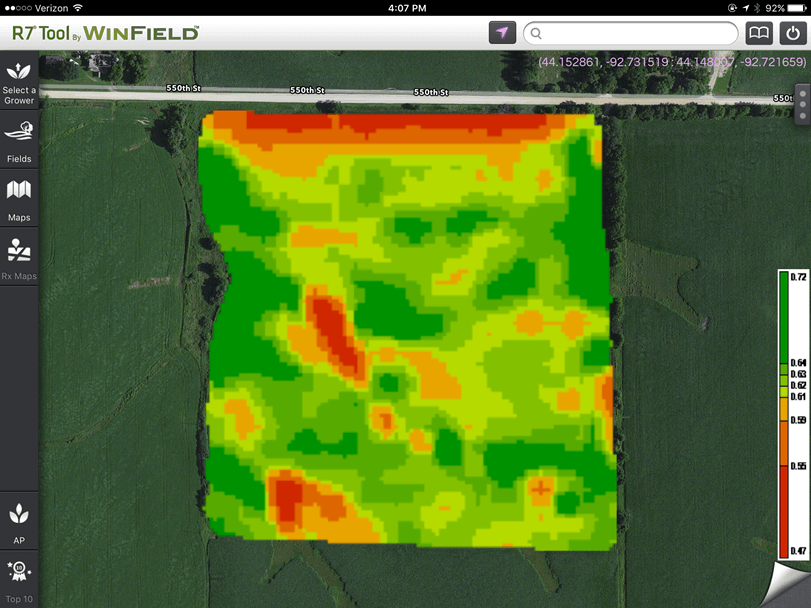Use Eye-Level, Sky-Level Views for Alfalfa Scouting

The question, “How can I be more efficient in scouting my alfalfa fields?” can likely be answered, “Through a combination of eyes-on-the-ground scouting and timely in-season images.”
In-season imagery is now being used by forage growers to make management and rotation decisions about their alfalfa crops. Identifying biomass variances lets you know exactly where to scout. A field with low biomass may just be a poor performer; but a traditionally high-performing field with low biomass could indicate insect or disease pressure.
In-season imagery, such as that available through the WinField R7® Tool, divides fields into zones and indicates low, medium or high biomass levels for each.
Combine eyeballing with imagery
To the naked eye, great alfalfa doesn’t really look much different from average alfalfa, unless there’s a big variance in the amount of biomass. By using in-season imagery, you can go out to specific field zones throughout the season to judge stand quality.
Then, pair that information with NutriSolutions® tissue sampling to detect deficiencies that can be addressed through nutrient applications. This is information you would not have if you just scouted by walking fields. However, viewing crops at eye level allows you to verify problems indicated by imagery, such as seeing precisely which insects or diseases are present; and you can confirm stand counts and height measurements.
Identify a threshold for comparison: 55 stems
You should scout alfalfa fields early in the season to decide whether rotation might be necessary. Do this by identifying the low-performing areas on the image and determine stem count and overall stand quality. If you have more than 55 stems per square foot, you can move on to evaluate the next field. Fewer than 55 stems per square foot may indicate that further evaluation is needed to determine if the crop should, in fact, be rotated.
Time your scouting
In-season imagery can be used anywhere between cuttings but the ideal time frame is often between seven to 14 days after cutting, once you begin to get early-season regrowth, to let you know where your alfalfa crop stands. This provides multiple opportunities to change management practices as necessary to improve your next cutting.
In-season imagery is now being used by forage growers to make management and rotation decisions about their alfalfa crops. Identifying biomass variances lets you know exactly where to scout. A field with low biomass may just be a poor performer; but a traditionally high-performing field with low biomass could indicate insect or disease pressure.
In-season imagery, such as that available through the WinField R7® Tool, divides fields into zones and indicates low, medium or high biomass levels for each.
Combine eyeballing with imagery
To the naked eye, great alfalfa doesn’t really look much different from average alfalfa, unless there’s a big variance in the amount of biomass. By using in-season imagery, you can go out to specific field zones throughout the season to judge stand quality.
Then, pair that information with NutriSolutions® tissue sampling to detect deficiencies that can be addressed through nutrient applications. This is information you would not have if you just scouted by walking fields. However, viewing crops at eye level allows you to verify problems indicated by imagery, such as seeing precisely which insects or diseases are present; and you can confirm stand counts and height measurements.
Identify a threshold for comparison: 55 stems
You should scout alfalfa fields early in the season to decide whether rotation might be necessary. Do this by identifying the low-performing areas on the image and determine stem count and overall stand quality. If you have more than 55 stems per square foot, you can move on to evaluate the next field. Fewer than 55 stems per square foot may indicate that further evaluation is needed to determine if the crop should, in fact, be rotated.
Time your scouting
In-season imagery can be used anywhere between cuttings but the ideal time frame is often between seven to 14 days after cutting, once you begin to get early-season regrowth, to let you know where your alfalfa crop stands. This provides multiple opportunities to change management practices as necessary to improve your next cutting.

